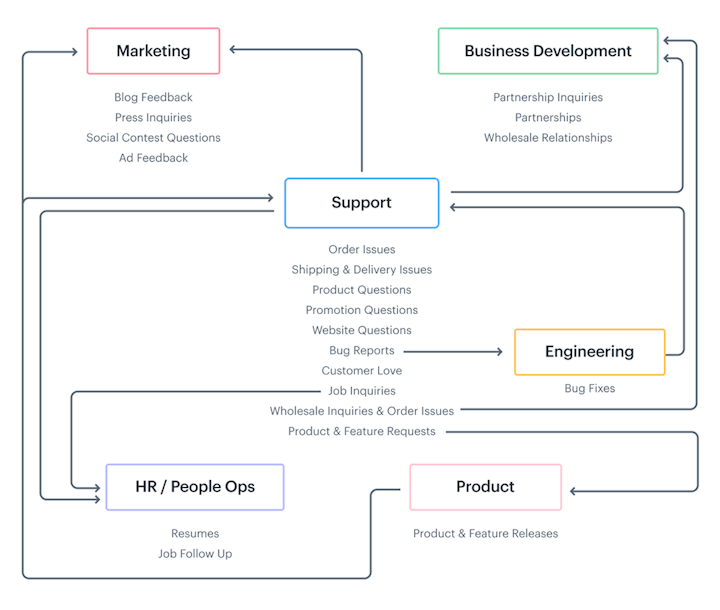5 Ways to Automate Support Without Degrading Service


The word automation dredges up some terrible imagery. From mindless robots to customers repeating their requests ad infinitum, customer support automation hardly has a good reputation.
Yet more and more companies are adopting automation as part of their customer service strategy. Why? Because when done well, support automation can give customers a better experience and reduce the stress on their teams.
Good vs. bad support automation
So what differentiates helpful customer support automation from unhelpful automation?
First, we need to understand what customers define as a good customer service experience. Across the board, customers say they value speed, consistency, and accuracy when they want help.
What they don’t want is impersonal, unfriendly service. A study by Nextive found that 33% of the customers who ended a business relationship last year did so because their interactions lacked personalization. They felt like the business didn’t care about them as a person.
Good automation helps humans deliver great support more effectively. It puts computers to use doing the things computers are good at: repetitive tasks and analyzing large amounts of data. Automations are very good at quickly doing the same things over and over again:
Tagging large amounts of data
Searching a database for information
Sending the same email repeatedly
Bad automation creates a barrier between customers and your company that feels impersonal and cost-reductionist. That might look like:
Scripted chatbots that don’t offer a way to talk to an agent
Awkwardly timed, repetitive, robotic emails
Creating hoops for customers to jump through before connecting them with support
Combining human qualities like empathy, personalization, and reasoning with the good parts of automation like speed, computer processing, and consistency can result in the best outcomes for everyone.
The benefits of customer support automation
Wouldn’t you love a personal assistant to run errands, answer emails, and tidy up after you? When automation is set up correctly, it’s like giving every agent on your team a PA.
The benefits of automation are wide-reaching, but here are just a few:
Customers get help faster. For questions that only need a straightforward answer, automated self-service can be the fastest way to get help. And customers don’t want to wait around for help: According to Forrester, 73% of customers say that “valuing their time is the most important thing a company can do to provide them with good online customer service.”
Support teams have more time for complex requests. Not only do the customers with straightforward questions get faster responses, but complex queries get better support, too. When some of the workload is resolved through automation, agents can spend more time dealing with complex issues that require more thought and investigation.
Agents feel more valued. A recent survey by DigitalGenius found that agents reported “40% of all customer tickets are mind-numbing and repetitive.” No agent wants to be stuck responding to the same password reset inquiries all day long. When you automate the simple tasks, agents can dig their teeth into more rewarding and enriching work.
5 helpful ways to automate customer support
When looking for ways to automate support, start by looking for repetitive actions. If you’re always asking customers for the same information or clicking the same buttons to move a conversation into a specific inbox, that process is likely primed for automation.
Here are five helpful ways you can use automated tools to improve your customer experience.
1. Send customer satisfaction surveys
One of the first automations any customer support team starts with is sending out customer satisfaction (CSAT) surveys. After a case is marked as “resolved,” an email is sent to the customer asking if they are satisfied with the service.

If a human was responsible for manually emailing out all those surveys, not only would it take a ton of time, but they likely would miss a few emails along the way. Automation makes CSAT survey collection a no-brainer.
But you can even take that automation one step further. When a customer responds negatively to a CSAT survey and gives feedback, your help desk can automatically open a case so that you can follow up and resolve the issue. Closing the loop on CSAT surveys can help you turn a dissatisfied customer into a loyal advocate.
2. Let customers know you received their questions
When a customer emails your support team, what happens next? Behind the scenes, your team is likely looking into their account, checking on the status of bugs with the engineering team, and composing a helpful reply. But your customer doesn’t know that.
Auto-reply emails can help set better expectations with your customers. They’re an automated email that tells your customer “Yep, we’ve got this!” and provides more information they might find helpful.

Source: Really Good Emails
Without auto-reply emails, your customers can feel like they are writing into a black hole, especially if they fill out a contact form on your website.
Use a well-written auto-reply email to reassure customers, and you’ll stand out from the crowd. In fact, 90% of companies don’t acknowledge receipt of customer service emails, and 62% of companies don’t even respond to them at all!
3. Direct customers to your help center articles
If you offer chat support, you can use automation to answer customer questions by directing them to the appropriate knowledge base article.
Depending on the live chat software you use, that might be achieved with a chatbot or by using a tool like Help Scout's Beacon that surfaces relevant help center articles in the same place where customers can initiate a chat.

However, keep in mind that chatbots can be infuriating when they try to do too much without giving customers an option to opt-out. No one wants to be stuck in a loop, trying to guess the magic words that will make the chatbot helpful.
For complex or sensitive topics, chat automation tools should help connect the customer to the right human and then butt out.
Make your website or app more helpful
Beacon lets you suggest relevant help content, offer live chat, and give customers instant access to their support history — all without leaving your site.
Try for free4. Organize your support queue
When new cases are opened, do they all go into one giant pile? There’s likely a ton of junk clogging up the queue that your support team spends energy redirecting when they could be spending that energy on your customers.
No one in support needs to keep a chart of who gets what sorts of requests or to spend time guessing where to send certain non-support-related conversations. They only need to know what type of conversation it is and let the automation do the heavy lifting.
Fix the problem by drawing out an ownership map of who gets what, including certain notifications and whether or not they need to be kept for records or just tossed completely.

Then, use automation to prioritize, organize, escalate, and redirect conversations. Add drop-down fields to contact forms to forward requests to the right teams, create tags to escalate urgent requests, or use workflows to prioritize support for users on a specific plan type.
The best part is that customers won’t even realize they have been touched by automation. Instead, it will feel like magic when the exact person they need to speak to replies quickly.
5. Reply quickly with saved replies
Saved replies, canned responses, or macros are pre-saved snippets of text that can be inserted into messages and then personalized.
They save time because agents don’t need to type out the same full response every time a frequently asked question arises. Writing a new response for each one uses up effort that could be better spent elsewhere. Reduced typing time buys back more attention for reading customer requests carefully and troubleshooting.
Saved replies are also helpful because you can provide your agents with the best possible response to use to consistently provide great service.
But be careful! It will frustrate customers if your team becomes too heavy-handed using saved replies that seem robotic, aren’t directly applicable, or are used too frequently. Take the time to personalize each saved reply when sending it.
Looking for more ideas? Check out this webinar on easy automations for busy support teams, featuring Brightback's Mo McKibbin along with Thomas Hils and Andra Roston of Zapier.
Add the power of automation to your customer support toolkit
Just like you wouldn’t expect a carpenter to build a house without power tools, we shouldn’t expect customer support teams to help without automation.
Using smart automation to improve your agent’s capabilities is just good business. It reduces the workload on your team and customers get answers faster: a win-win for everyone involved.
The Supportive Weekly: A newsletter for people who want to deliver exceptional customer service.




